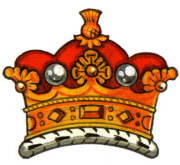
|
The Complete Guide to the British Peerage & Baronetage |
If you have found this page useful, why not make a donation to The Peerage Research Trust so that we can continue to maintain and develop Cracroft's Peerage?
____________________________________________________________________________________________________________
Marquesses of England

A marquess's coronet
The title of Marquess is said to derive from from the Italian word marchese, the ruler of a march or border territory. Certainly the local lords who guarded the Welsh and Scottish marches were collectively known as "lords marcher", but whether this had any connection with the origin of the second highest rank of the peerage remains doubtful. The first English marquessate was conferred in 1385 on Robert de Vere, who was created Marquess of Dublin and, in the next year, Duke of Ireland. However he was banished and attainted in 1388 and his honours forfeited. The second creation of a marquessate was a few years later, when John Beaufort, Earl of Somerset (eldest legitimated natural son of John "of Gaunt", Duke of Lancaster), was created Marquess of Dorset in 1397. He was degraded from his rank in 1399 and the title was re-created for his nephew, Edmund Somerset, Earl of Dorset, in 1443. The title survived until 1461, when it was extinguished by the attainder of Henry, Duke of Somerset, who had inherited it in 1455. William de la Pole, Earl of Suffolk, had been created Marquess of Suffolk in 1444 but this was merged into the Dukedom of Suffolk, which was created for him in 1448. A marquessate re-appeared as a separate title in 1470 when John Nevill was created Marquess of Montagu, but he was killed at the Battle of Barnet the next year and succeeded by his son, who had already been created Duke of Bedford. From 1475, however, when Thomas Grey, Earl of Huntingdon, was created Marquess of Dorset, the marquessate has been a regular and common grade of nobility.
A Marquess is styled the "Most Honourable" and he is officially addressed by the Crown as "Our Right Trusty and Entirely Beloved Cousin". This mode of address started in the reign of King Henry IV, who through his immediate family was related or allied to every Earl in the kingdom. When a Marquess or any other peer is a member of the Privy Council the word "Counsellor" is placed before his name, for instance: "Victoria......To Our Right Trusty and Entirely Beloved Cousin and Counsellor, Charles Robert, Marquess of Lincolnshire.....Greeting!".
He bears also, upon some occasions, the title of "Most Noble and Puissant Prince".
In common with all peers, Marquesses are entitled to both coronation and parliamentary robes. The Coronation Robe, which, as the name suggests, is worn only at the Coronation of the Sovereign, is of crimson velvet, edged with white fur and having three rows and a half of ermine on the white fur cape. Marchionesses are entitled to wear coronation robes similar to those of a Marquess, these being edged with a four inch border of white fur with a train a yard and three quarters on the ground. The Parliamentary Robe of Estate of a Marquess, which is worn for the State Opening of Parliament or by those taking part in the ceremony of Introduction of a new peer, is of fine scarlet cloth lined with taffeta. It is trimmed with three and a half guards (or bands) of ermine and gold lace, and is tied at the left shoulder with a white ribbon.
Coronet - A circle of gold, surmounted by four gold strawberry leaves and four silver balls alternately, the latter a little raised on points above the rim; a cap of crimson velvet, turned up ermine, thereon a golden tassel.
____________________________________________________________________________________________________________
ã Copyright: Heraldic Media Limited. All rights reserved.